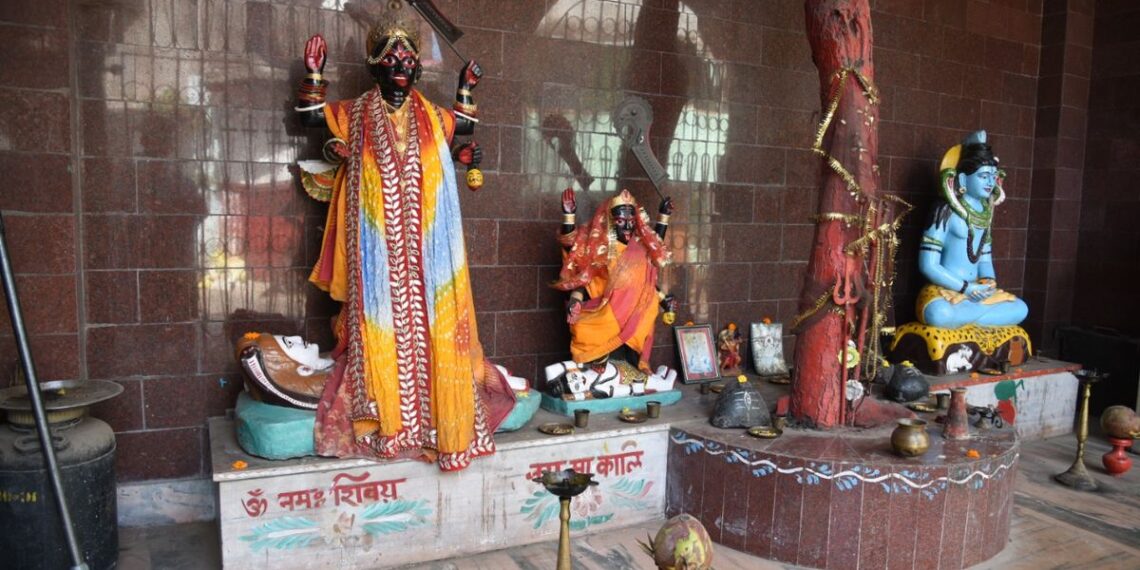Built by the local Chinese community, the Chinese Kali Temple in Tangra, Kolkata, West Bengal, is a small Hindu shrine dedicated to Goddess Kali. It is located on Matheswartala Road in Kolkata’s Chinatown, about 8 kilometers from the city’s heart, and stands out for merging Hindu and Chinese traditions. This blog gives detailed information about the temple’s past, its look, its role in worship, and how to visit the temple.
History of Chinese Kali Temple
The Chinese Kali Temple was established around the early 1960s in Tangra, Kolkata’s second Chinatown. It began with a miracle when a 10-year-old Chinese boy was very sick, and doctors gave up hope. His parents took him to a spot where locals prayed to two black stones under a tree, marked with red vermilion, as a form of Goddess Kali. The young boy’s recovery, after his family prayed for days to two sacred black stones beneath a tree, was nothing short of a miracle. Out of deep gratitude, the Chinese family, with help from their community, built a temple at that very spot, now known as the Chinese Kali Temple. Even today, the original stones and the tree remain at its heart.
The roots of Kolkata’s Chinese community go back to the late 18th century, beginning with Tong Atchew, who made his home near Budge Budge in what is now Achipur. Over time, more Chinese families settled in Territi Bazar, in the city’s center, and later in Tangra by the early 1900s, where they worked in tanneries before opening the first Chinese eateries. However, during the 1962 conflict between India and China, the community went through difficult times—some were sent to internment camps, others migrated to countries like Canada. But many still stayed behind, preserving their way of life while also embracing the Bengali traditions.
Architecture of Chinese Kali Temple
The Chinese Kali Temple is a small temple with granite walls and a simple but unique design. It has two arches at the entrance and a sign in Chinese and English that says “Chinese Kali Temple.” Inside, there are two idols of Goddess Kali and one of Lord Shiva, her partner, plus framed pictures of other Hindu gods. The ceiling has Chinese-style paintings of a dragon and phoenix, and the walls are painted red, like in Chinese temples. The two black stones from the original worship spot sit under the tree, keeping the temple’s story alive. The temple has no big carvings like other Hindu shrines but has Chinese touches, like lanterns and decorations.
Why It Matters for Worship
The Chinese Kali Temple shows a rare mix of faiths, where Chinese and Bengali people pray together to Goddess Kali, seen as a strong protector against evil. A Bengali priest, leads Hindu Vedic rituals, with prayers at 9:30 AM and 7:00 PM. But Chinese worshippers also light tall incense sticks and burn paper candles to keep bad spirits away, following their customs. The prasad, or holy offering, is unique, with noodles, chop suey, fried rice, and vegetarian Manchurian, different from the usual sweets or fruits at other temples. This comes from Tangra’s Indo-Chinese food culture.The temple is busiest during Kali Puja on Diwali, in October or November, and Chinese New Year, in January or February, when both groups celebrate together. It also has a Narayan shila, a sacred stone for Lord Narayan, so all offerings are vegetarian. The temple shows how faith can unite cultures, with some Chinese, like caretaker John Cheng, calling themselves “Chinese Hindus” and avoiding beef to respect local ways.
Things to Do at Chinese Kali Temple
Visitors can do things that mix prayer, culture, and local life:
Join Prayers: Watch or join the morning or evening aarti, with Vedic chants and Chinese incense lighting.
See the Temple: Look at the dragon and phoenix paintings, Kali and Shiva idols, and the old stones under the tree.
Eat in Tangra: Try Indo-Chinese food at places like Kim Fa, with dishes like vegetable pak choi.
Walk in Chinatown: See Tangra’s colorful buildings, lanterns, and Chinese shops
See the Temple
Look at the bright dragon and phoenix paintings on the walls. You’ll also find idols of Kali and Shiva, and the old black stones still sitting under the tree.
Visit Nearby Places: Go to Science City, 3 kilometers away, or Park Street, 5 kilometers away, for more Kolkata sights.
Visiting Information for Chinese Kali Temple
How to Get There
The temple is at G9VV+Q26, 41 Matheswartala Road, Tangra, Kolkata, 8 kilometers from the city center.
By Plane: The closest airport is Netaji Subhas Chandra Bose International Airport, 15 kilometers away. Taxis or app cabs take 40–50 minutes to Tangra.
By Train: Beliaghata Road Railway Station is 1.1 kilometers away, about 10–15 minutes by auto-rickshaw or taxi. From Howrah Station, 8 kilometers away, or Sealdah, 5 kilometers away, take a bus, taxi, or metro to Salt Lake Stadium Metro Station, 1.9 kilometers from the temple, then walk or take a rickshaw.
By Road: From central Kolkata, take APC Road to Matheswartala Road, about 20–30 minutes. Buses or taxis from Esplanade or Park Street work well. Parking is tight, so public transport is better.
Temple Hours
The temple is open daily from 5:00 AM to 2:00 PM and 5:00 PM to 8:00 PM. Evening prayers start at 7:00 PM. During Kali Puja or Chinese New Year, it may stay open longer. Ask locals for exact times.
Best Time to Go
Visit from October to February, when it’s 15–25°C, good for walking. Kali Puja (October–November) and Chinese New Year (January–February) are busy but fun. Summers (April–June) are hot, up to 35°C, so go early. Rainy months (July–September) make streets wet.
Rules for Visitors
Wear plain clothes: men need shirts and trousers and women need sarees, salwar kameez, or long dresses. Take off shoes; there’s a place to keep them. No photos are allowed inside. Don’t smoke, drink alcohol, or bring food. Stay quiet during prayers. Offerings like noodles must be vegetarian. Keep the place clean and don’t litter.
Final Words
The Chinese Kali Temple in Kolkata’s Tangra is a rare spot where Hindu and Chinese faiths come together. Visiting here lets you feel Goddess Kali’s strength and Tangra’s special Chinatown life. Plan a trip to see this mix of faith and history.











